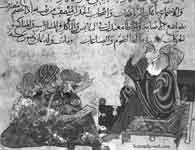.
The astrolabe is a device for solving problems relating to time and the position of the Sun and stars in the sky. Several types of astrolabes have been made. By far the most popular type is the planispheric astrolabe, on which the celestial sphere is projected onto the plane of the equator. The name astrolabe is derived by aster and lambanein, i.e., star and receive or get and means combined a device that finds a star. The word stereographic is derived from stereos “solid” and “graphein” to write, i.e. it describes the drawing of the projections of solid objects. A stereographic projection is used for the mapping of the celestial sphere on the astrolabe plane (a so called conformal -angle preserving – projection, that maps circles to circles).
Astrolabes are used to show how the sky looks at a specific place at a given time. This is done by drawing the sky on the face of the astrolabe and marking it so positions in the sky are easy to find. To use an astrolabe, you adjust the movable components to a specific date and time. Once set, the entire sky, both visible and invisible, is represented on the face of the instrument. This allows a great many astronomical problems to be solved in a very visual way. Typical uses of the astrolabe include finding the time during the day or night, finding the time of a celestial event such as sunrise or sunset and as a handy reference of celestial positions. Astrolabes were also one of the basic astronomy education tools in the late Middle Ages. Old instruments were also used for astrological purposes. The typical astrolabe was not a navigational instrument although an instrument called the mariner's astrolabe was widely used. The mariner's astrolabe is simply a ring marked in degrees for measuring celestial altitudes.
The origins of the astrolabe were in classical Greece. Apollonius (ca. 225 BC), the great codifier of conic sections, probably studied the astrolabe projection.
The most influential individual on the theory of the astrolabe projection was Hipparchus of Rhodes (called also Hipparchus of Nicaea or Hipparchus of Bithynia) (c. 190 – 120 BC) who was born in Nicaea in Asia Minor studied and worked on the island of Rhodes. Hipparchus, who discovered the precession of the equinoxes was influential in the development of trigonometry, redefined and formalized the projection as a method for solving complex astronomical problems without spherical trigonometry and probably proved its main characteristics. Hipparchus did not invent the astrolabe but he did refine the projection theory. Some consider that Hipparchus knew the properties of the stereographic projection.
The earliest evidence of use of the stereographic projection in a machine is in the writing of the Roman author and architect, Vitruvius (c. 88 - c. 26 BC), who in De architectura describes a clock (probably a clepsydra or water clock) made by Ctesibius in Alexandria. Apparently, Ctesibius' clock had a rotating field of stars behind a wire frame indicating the hours of the day. The wire framework (the spider) was possibly constructed using the stereographic projection with the eye point at the north celestial pole. Similar constructions dated from the first to third century and have been found in Salzburg and northeastern France, so such mechanisms were apparently fairly widespread among Romans.
The first major writer on the projection was the famous Claudius Ptolemy (ca. AD 150) who wrote extensively on it in his work known as the Planisphaerium. There are tantalizing hints in Ptolemy's writing that he may have had an instrument that could justifiably be called an astrolabe. Ptolemy also refined the fundamental geometry of the Earth-Sun system that is used to design astrolabes.
No one knows exactly when the stereographic projection was actually turned into the instrument we know today as the astrolabe. Theon of Alexandria (ca. 390), the father of Hypatia, wrote a treatise on the astrolabe that was the basis for much that was written on the subject in the Middle Ages. Synesius of Cyrene (378-430) apparently had an instrument constructed that was arguably a form of astrolabe. This is plausible since Synesius was a student Hypatia. The earliest descriptions of actual instruments were written by John Philoponos of Alexandria (known also as Joannes Grammaticus) in the sixth century and a century later by Severus Sebokht, Bishop of Kenneserin, Syria, although it is likely that Sebokht's work was derivative of Theon.
The Astrolabe was mainly developed in the Islamic world after the translation of Greek manuscripts around 800 AD in a period of ca. two centuries and around 1000 AD it reached its final form known to us. From the islamic world it was introduced in Europe during the next 3 centuries. Until the 17th century the instrument was further developed and special versions were produced.
Miscellaneous
Vitruvius tells us that Eudoxus used an instrument that he called arachne (spider), a sundial, that some consider to be one one of the origins of the astrolabe.
LINKS
Geoffrey Chaucer on the Astrolabe (1391 AD a translation or if you prefer the original text)
Ptolemy's Spherical Astrolabe (Armillary Sphere)
Build your own Astrolabe and Use it!
| Ancient Greece
Science, Technology , Medicine , Warfare, , Biographies , Life , Cities/Places/Maps , Arts , Literature , Philosophy ,Olympics, Mythology , History , Images Medieval Greece / Byzantine Empire Science, Technology, Arts, , Warfare , Literature, Biographies, Icons, History Modern Greece Cities, Islands, Regions, Fauna/Flora ,Biographies , History , Warfare, Science/Technology, Literature, Music , Arts , Film/Actors , Sport , Fashion --- |


